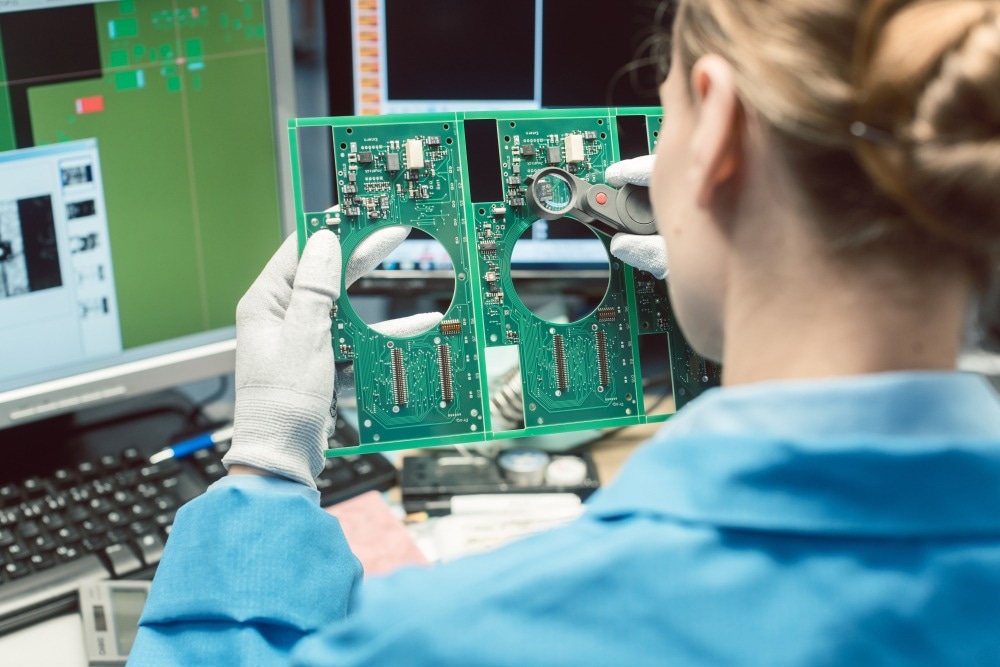In a recent study published in Processes, a group of researchers found that using product image data from an automated optical inspection (AOI) system to gather useful information increases the effectiveness of anomaly detection during product inspection. The researchers used a visual geometry group network, Inception V3, and Xception algorithms to differentiate between qualified and unqualified products during product image analytics.

Study: Developing an Anomaly Detection System for Automatic Defective Products’ Inspection. Image Credit: Kzenon/Shutterstock.com
The analysis results incorporated a cloud system developed for human-machine interaction. Users receive reminders about anomaly detection by using the suggested cloud system, which includes a message queuing telemetry transport protocol, a cloud dashboard, and an application programming interface.
Automated Optical Inspection (AOI) System
An automated optical inspection (AOI) system is a visual device that automatically takes product images during an inspection.
Poor quality products result in enterprise revenue losses. Therefore, inspection of products is crucial for preserving product quality.
An automated optical inspection (AOI) system is an effective tool for product inspection that offers consumers an easy interface to inspect their desired products.
Limitations of Automated Optical Inspection (AOI) System
A human visual inspection of the AOI system's dashboard is the traditional approach used in the screw production sector. The inspector's experience significantly impacts the inspection findings, regardless of the inspector or the method employed.
The inspector observes the captured image on an AOI dashboard to find damaged products. Whether or not the product is defective is decided by the inspector's subjective evaluation.
The inspector can conduct a flawed inspection. Therefore, a more accurate method is needed to increase the effectiveness of anomaly detection.
Strategies to Enhance Anomaly Detection
Internet of things (IoT)-related equipment (such as internet-connected devices, sensors, and software applications) is utilized in cyber-physical systems (CPS). As a result, during internet-connected production, significant industrial data is acquired within the CPS environment.
Data gathered from CPS can be examined to uncover defective patterns automatically. A human visual inspection lacks accuracy for anomaly detection. Information technology, business procedures, and other forms of mechanization are all included in automation.
Due to the widespread use of cloud technology in automation applications, data-driven anomaly detection increases inspection efficiency. Utilizing specialized software and approaches, automating human operations can enable auto notification when spotting an abnormality.
Cloud technologies have been widely used to function automatically in human and machine communication. Examples include the message queuing telemetry transport (MQTT) protocol, web programming, and application programming interface (API).
Incorporating Deep Learning Approaches to Anomaly Detection
Deep learning algorithms enhance the effectiveness of human visual examination, solving anomaly detection issues.
Hung et al. used the visual geometry group network (VGG-16), Xception, and Inception V3algorithms for actual industrial image datasets. Cloud dashboards, data communication, and auto-notifications systems were developed by researchers for the proposed system using the MQTT protocol, API, and web development techniques.
The researchers also examined the difference in classification performance between various convolutional networks and training data sizes and investigated the detection of abnormal product quality using deep learning approaches.
It enabled real-time communication and visualization by developing a communication protocol to activate data acquisition (SCADA) and real-time supervisory control. It automatically transfers the inspection result from the product to their database.
Research Findings
A significant problem during screw inspection is defective human visual examination, which raises the issue of human errors and increases inspection times.
Hung et al. provided a practical automated anomaly detection system that uses deep learning and cloud computing. The researcher used VGG-16, Inception V3, and Xception to analyze data from the AOI system and identify damaged screw surfaces from a data analytics perspective.
Compared with VGG-16, the Inception and Xception produced better inspection results.
The performance of the models and the amount of training data were examined in this study. The suggested VGG-16 result demonstrated a performance difference between training dataset sizes. The depth of VGG-related networks was constrained. The training data size could be constrained by the results' correctness.
According to the experimental results, a more extensive training dataset with VGG-16 had greater accuracy and precision than a smaller training dataset. Detecting plating surface defects was the most challenging of all fault categories.
Deep learning has excellent precision and accuracy for an overall assessment. The outcomes confirm the robustness of convolutional-related networks with transfer learning to accurately detect the damaged surface of a screw.
Reference
Hung, Y.-H. (2022). Developing an Anomaly Detection System for Automatic Defective Products’ Inspection. Processes, 10(8), 1476. https://www.mdpi.com/2227-9717/10/8/1476
Disclaimer: The views expressed here are those of the author expressed in their private capacity and do not necessarily represent the views of AZoM.com Limited T/A AZoNetwork the owner and operator of this website. This disclaimer forms part of the Terms and conditions of use of this website.